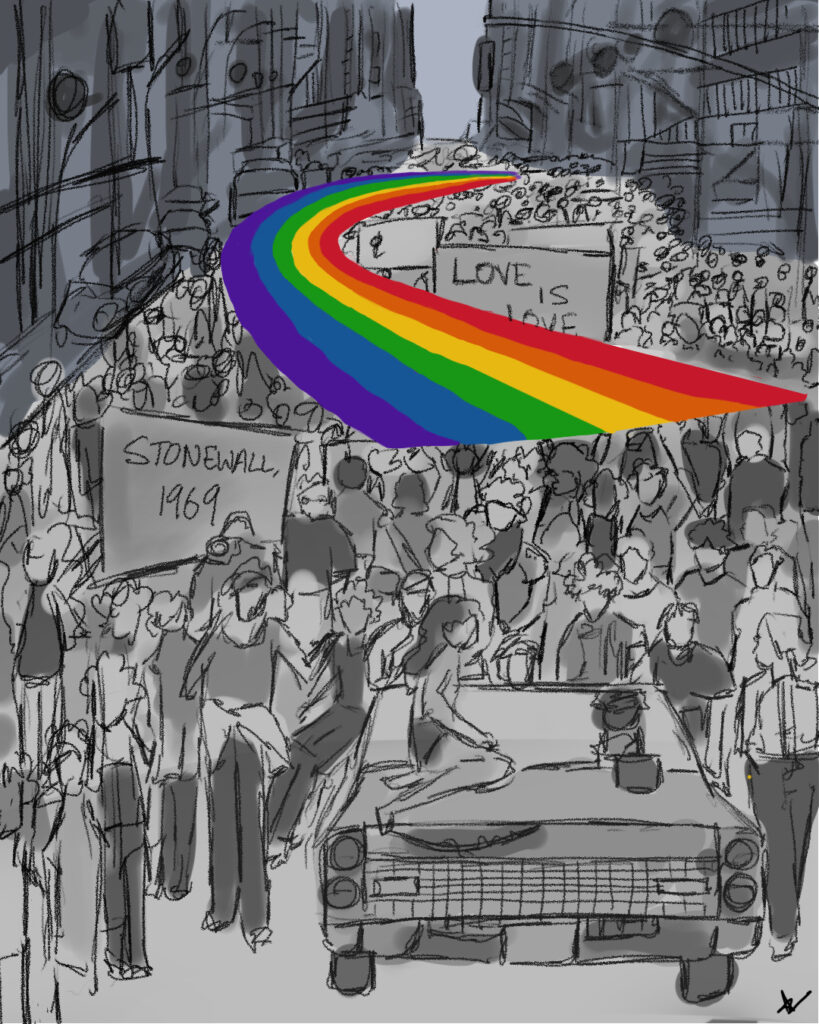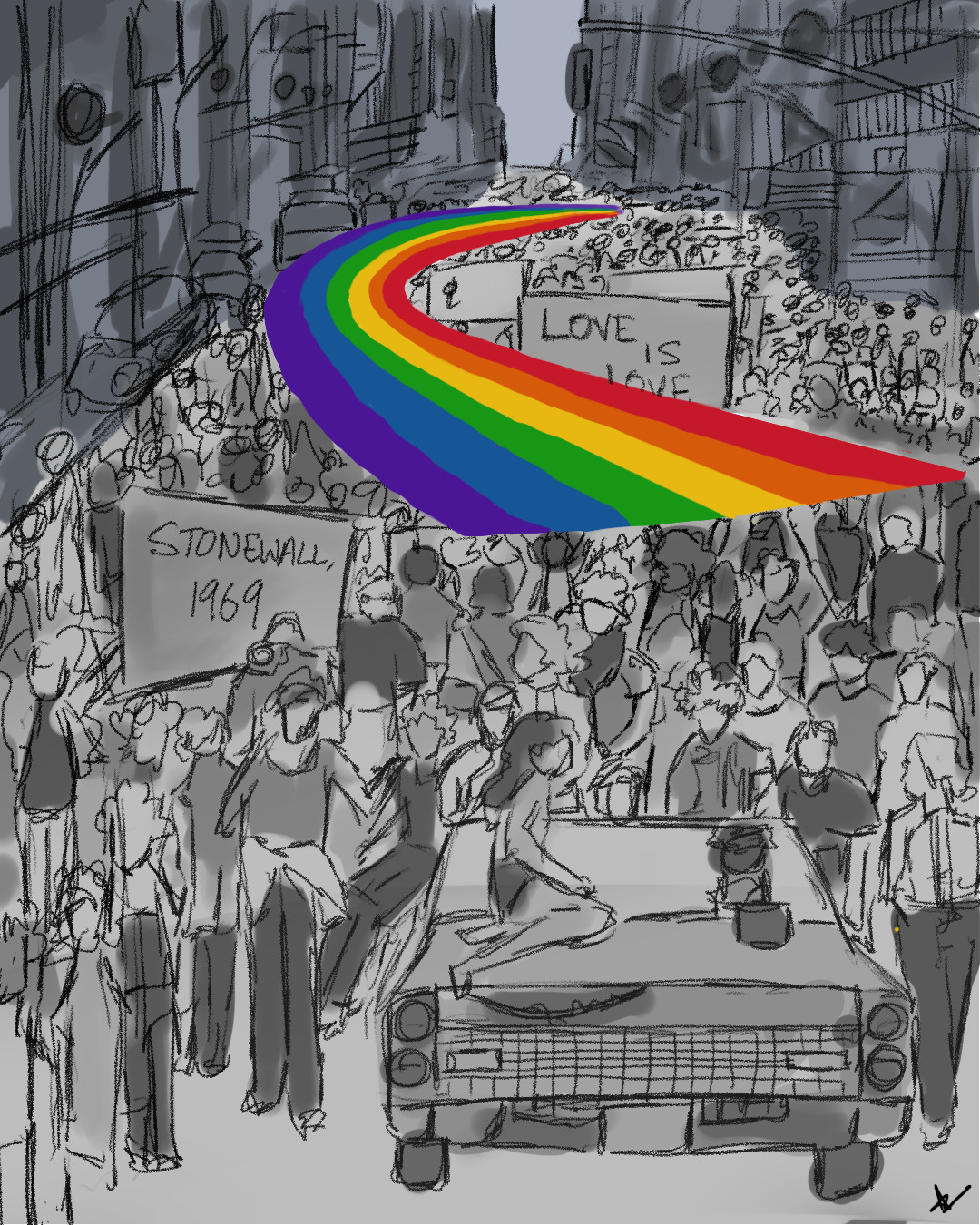
Imagine this: It’s a warm summer day, and you’re just walking down the street sucking on the icy exterior of a watered-down popsicle when somebody walks past you. They smell incredible and have grace in their strut. You turn back to see who it is but don’t dwell much on it because the popsicle might melt, and you don’t want sticky fingers that reek of sugar.
In the not-so-distant past, queer people would find themselves trying to abide by the ideals of heteronormative cultures to save themselves from the trauma they’d have to endure if their true identity was revealed. The tricky thing about identity is, the more you constrict it, the more you’re going to falter. Like the Madonna song “Express Yourself”, identity’s fluid nature finds ways to express itself. It can be through a strut, a phenomenal scent; maybe the brown of their briefcase is more profound because they like the dark or the pin on their coat has a more lustrous gold, for they like their things shiny.
Your popsicle might come in flavours, but identity doesn’t come in packages; it is as biological as the process of reproduction. It is just that years of generational abuse under the garb of normalcy has forced us to misconstrue the entire idea around people finding the need to express themselves in ways that might not be similar to the quintessential humans’. A person’s identity isn’t a fixed label set in stone; it is ever-changing, subject to what the person learns about themselves. It evolves with time, knowledge and experience.
Pre Stonewall
In the west, regular sweeps were held everywhere, from casual establishments to esteemed universities, to “rid the State of gay people”. They were then regarded as perverts and security risks. Firing individuals for merely suspecting what their sexuality was was a common sight, and donning “clothes of the opposite gender” was outlawed. Up until 1974, homosexuality was listed as a psychological disorder; it was only after studies failed to provide a substantial basis for the same that it was declassified and officially regarded as a natural sexual orientation. Some major paradigm shifts have taken place revolving around the times different sexualities were studied.
Although the Stonewall riots are considered the impetus of the events contributing to the liberation of people in the community, demonstrations were held in small pockets in major cities. These were actions of civil resistance usually led by organizations advocating for the community. There was a resistance to policing forces in major cities, especially in Europe, and campaigns for social reform conducted by the organizations. Just for a chance to be heard, they were required to follow strict dress codes made for them.
The Stonewall Riots
Queer people were generally not welcome to establishments—places they were allowed into were owned by crime families, as was the Stonewall Inn, which was converted to a club located in Greenwich Village in New York City. Stonewall was relatively larger and more welcoming than other clubs. It welcomed drag queens who were struggling with acceptance during those times, but Stonewall gave them the much-needed refuge and the ability to feel safe.
Until 1966, liquor stores were not even allowed to serve liquor to queer people because it was perceived as ‘disorderly’ behaviour. Since times immemorial, law-making has been handled by cisgender-heterosexual people; people who conform to society’s restricting gender ideals. As a result, in situations like the one in 1966, when they have the reigns to make decisions for people that threaten their societal ideals, the decisions are often lopsided and detrimental to the community, since a cisgender-heterosexual person could never relate to queer experiences.
Activists rallied and the regulations regarding alcohol provisions to queer people were overturned in 1966. The queer people who went to Stonewall had to build their own system to figure out whether militant forces were in their midst. This let them run at a moment’s notice, since raids on these establishments were still very common.
On the night of June 28th, 1969, police barged into the club and arrested people who weren’t wearing clothing that conformed to gender ideals. Previously, the people in the club didn’t engage in violence with the police and kept low; that didn’t happen this time. The people in the bar were exhausted by the barbarism at the hands of lawmakers. They decided to push back and protest for their rights. The crowd grew by about ten times in size, with an increasing number of people joining the fight. This sparked a movement that would forever be remembered as a bookend in the crusade for queer rights. The protests went on for almost a week.
Post Stonewall
With the queer liberation movement came a surge of pride, with people who wished to do so, going all out with expressing themselves—previously a rarity, considering how their lives could be at stake if they tried. There was a surge of solidarity; more and more people came out. This significantly increased traction and helped solidify the wall of resistance that would help create the modern liberation movement for what it is today.
The first annual pride parades were held on the anniversary of the Stonewall riots across multiple major cities in the US. This practice continues today across the world and is usually held during the later half of June. It signifies a celebration in the fight for fundamental rights and acts as a safe space for whoever needs it. The “symbol” of pride, the rainbow flag, became popular in the San Francisco pride in 1978, where it made its debut. Once a way to celebrate one’s identity, the parades went on to also become a space for participants to advocate for social justice. Besides the main rainbow flag, there are now many flags for different orientations.
Out and Proud
The onset of the Punk movement in the ‘70s and the subsequent ‘80s saw a shift in the queer rights movement. There was a certain urgency and a hunger for recognition. Along with that, people started experimenting more with music and their clothing, freeing themselves of the shackles created by the restricting governments. During these times, some of the most prominent figures like Elton John and Freddie Mercury, who sported gender-fluid clothing and dared to question their sexuality, helped further the agenda of normalising the community. There was a spurt in the representation of queer people in a lot of industries—majorly in music and politics. Unfortunately, this was primarily relegated to negative connotations.
In the late ‘80s and the ‘90s the AIDS Epidemic was largely attributed to the queer community, which seemed to have undone their progress by just a bit. The community instead put up a more united front, encouraging various leaders around the world to call for normalization and setting up AIDS societies to help those affected.
The Liberation Movement, Today
The word “Queer” is regarded by a majority as an umbrella term incorporating inclusivity for any member who is not heterosexual and/or cisgender. Its original usage was as a slur, directed at everyone who was not “normal” with regards to their sexual orientation and expression, in the eyes of the majority. In the ‘80s, queer activists began to reclaim the word. Although those directly affected by the slurs avoid its usage, most people stick to it to avoid exclusion of any orientation. It is also useful for those in the community who don’t want a specific label or are unsure of their identity. Other words that have a history of harm to the community are considered derogatory, and it is only right that those slurs can be reclaimed by those it had oppressed and them alone.
You might’ve noticed the increasing number of people coming out as queer. This exponential growth is by no means just a “current trend” that’ll die out—the truth is far from it. With the increasing amount of people and information on the internet, people have the opportunity to learn. There is free access to information about something that they initially might not have understood, since they’ve learnt otherwise their entire lives. The chance to connect with someone just like them, someone with whom they’d never normally cross paths. A way to realise that they’re not alone; a way to finally understand who they are (with scientific evidence, too) and that it’s perfectly normal.
The internet isn’t a bad influence that “changed” people; it is a powerful arena helping people get closer to their identity in a way that may have otherwise taken a lifetime. There’s still a world here against queer people, but there’s also a safe space for anyone who wants it. This is why more people can, and are, proudly coming out everyday— acceptance.
Understanding Labels
Labels today are vast—understandably. Harmful stereotypes have been perpetuated over the decades, that make us feel like we have the leeway to assume one’s sexuality and consequently misgender them in some cases. It’s not a solid box with rigid slots wherein you can assign someone one of the labels from the LGBT acronym, based on your assumption. It is a spectrum; you are whatever you genuinely identify as, and you can be anywhere on it.
Labels, to some, are optional. It could be because they aren’t sure about it, or perhaps it doesn’t really matter to them. To some people, labels are crucial—it may ground them, give them the words they’ve been trying to form, or maybe their experience has made it important to them in some way. Yes, labels can be confusing, given that there is a spectrum on which people identify themselves. It is not a solid this-or-that situation, in the end; what they believe suits them, concerns only them.
If you really want to start somewhere, start using gender-neutral words and asking people their preferred pronouns. If you are not well-versed, listen and educate yourself. Respecting someone’s identity and sexuality and just making them feel comfortable goes a long way; at the very least, just let them be.
Written by Avaneesh M and Ishita Gaur for MTTN
Edited by Aakanksha Mantri for MTTN
Featured Image by R.S. Aruna for MTTN

Leave a Reply
You must be logged in to post a comment.